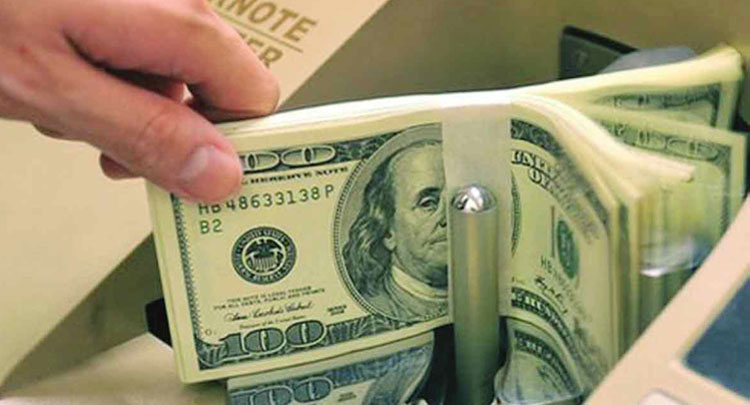Negative remittance inflows may affect future growth
Domestic demand buoyant, says BB quarterly report
 The current negative growth in remittance inflows might have some adverse effects on domestic demand, the central bank said, thereby possibly affecting country's economic growth.
The current negative growth in remittance inflows might have some adverse effects on domestic demand, the central bank said, thereby possibly affecting country's economic growth.
From the demand side, strong private-sector-credit growth and capital-machinery-import growth indicate buoyant domestic demand, according to the latest quarterly report of the Bangladesh Bank (BB).
 "However, the negative growth in remittance inflows (-15.3 per cent) might have some moderating effects on the domestic demand," the central bank said in its latest Bangladesh Bank Quarterly (BBQ) for January-March 2017.
"However, the negative growth in remittance inflows (-15.3 per cent) might have some moderating effects on the domestic demand," the central bank said in its latest Bangladesh Bank Quarterly (BBQ) for January-March 2017.
The BB's latest observations came against the backdrop of falling trend in the flow of inward remittances in recent months.
It happened due to a sluggish trend in economic activities in the Middle-Eastern countries along with a rising trend in sending hard-earned money by expatriate Bangladeshis using informal channels, according to the central bank officials.
They also said the overall economic growth may face an adverse impact in future if the existing downward trend of inward remittance continued.
"It may be visible in the next fiscal if the falling trend in inward remittance persists," a BB senior official told the FE Wednesday while explaining possible impacts of the negative growth in inward remittances.
He also said the government as well as the central bank of Bangladesh is now working to revamp the inflow of remittance shortly.
The BBQ also said the country's overall economic activity maintained its momentum during the third quarter (Q3) of the outgoing fiscal year (FY) 2016-17.
The industry sector benefited from domestic demand, with output in the large-and medium-scale industries growing by 10 per cent in the Q3 of FY 17.
The growth in bank credits to trade and commerce sectors (13.3 per cent) and the increase in the Chittagong port cargo volume (9.5 per cent) suggest a solid performance of the service sector.
The recent floods in the northern haor areas of the country had localised impact in the agriculture sector, the BBQ noted.
"Favourable inflation dynamics benefited from declining non-food inflation, while food inflation (12-month average) rose modestly since September 2016," the BB explained in its latest BBQ.
Besides, non-food inflation (point to point) has been on the rise since the beginning of the Q3.
Recent developments increase the probability of higher inflationary pressures over the coming months, the central bank hinted.
However, consumer price index (CPI) inflation on 12-month-average basis declined to 5.4 per cent in March 2017, well below the 5.8 per cent target in the FY17 budget.
Country's banking-sector indicators depict a mixed picture during the period under review.
The BBQ says capital-to-risk-weighted-asset ratio (CRAR) and asset quality (NPLs) in the banking system softened, while the provision-shortfall position of banks against classified loans improved.
The ratio of gross NPL to the total outstanding loans of the banking sector increased from 9.2 per cent at end-December 2016 to 10.5 per cent at end-March2017.
Moreover, the ratio of net NPL to the total outstanding loans of the banking sector rose to 2.9 per cent from 2.3 per cent during the same period.
The CRAR remained largely unchanged at around 10.7 per cent in March 2017.
Despite the deterioration in NPL, provision-shortfall position of the banking sector improved in March 2017 and stood at Tk (-) 52.3 billion from Tk (-) 54.7 billion at the end of December 2016.
The spread of monthly weighted average lending rates and deposit rates in the banking sector remained below 5.0 per cent and the inter-bank money-market rate was stable around 3.6 per cent, reflecting adequate market liquidity.
During the quarter under review, the Bangladesh Taka (BDT) exchange rate against the US dollar depreciated modestly (1.22 per cent), reflecting the market forces.
The BB bought $45 million in January 2017 and sold $ 22 million and $23 million on the foreign-exchange market in February and March 2017 respectively, according to the quarterly report.
"Real effective exchange rate also depreciated modestly due to the depreciation of nominal exchange rate and falling domestic prices," it noted.
news:financial express/22-jun-2017
Other Posts
- Shahjalal Islami Bank gets new AMD
- New MD for Southeast Bank
- FSIBL inks deal with BREB
- Dr Zaed Bakht, Chairman of the Board of Directors of Agrani Bank Limited, presiding over its 10th Annual General Meeting at Bangabandhu International Conference Center, ‘Green View Hall,’ Shere-E- Bangla Nagar in city recently.
- BB for uninterrupted ATM, MFS services during Eid vacation
- Govt to mobilise Tk 20,000cr from banks for power projects
- Govt borrowing from saving instruments likely to exceed target in FY2016-17
- One more NBFI gets BB licence
- Govt-ADB ink $300m loan deal for railway




Comments